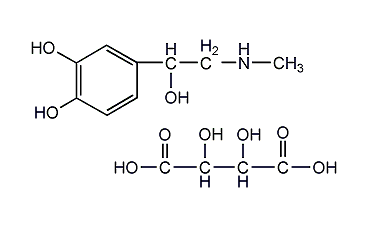
Structural formula
| Physical competition number | 014T |
|---|---|
| Molecular formula | C13H19NO9 |
| Molecular weight | 333.29 |
| label |
L-3,4-dihydroxy-alpha-((methylamino)methyl)benzyl alcohol D-bitartrate, C9H13NO3·C4H6O6 |
Numbering system
CAS number:51-42-3
MDL number:MFCD00035077
EINECS number:200-097-1
RTECS number:DO3500000
BRN number:None
PubChem number:24277774
Physical property data
1. Characteristics: white crystalline powder. No odor and bitter taste.
2. Density (g/mL,25/4℃): Undetermined
3. Relative vapor density (g/mL,AIR=1): Undetermined
4. Melting point (ºC):147 -152
5. Boiling point (ºC,Normal pressure): Undetermined
6. Boiling point (ºC,5.2kPa): Undetermined
7. Refractive Index: Undetermined
8. Flashpoint (ºC): Undetermined
9. Specific optical rotation (ºC=1, in water):-17
10. Autoignition point or ignition temperature (ºC): Undetermined
11. Vapor pressure (kPa,25ºC): Undetermined
12. Saturated vapor pressure (kPa,60ºC): Undetermined
13. Heat of combustion (KJ/mol): Undetermined
14. Critical temperature (ºC): Undetermined
15. Critical pressure (KPa): Undetermined
16. Oil and water (octanol/Log value of the partition coefficient of water:
17. Explosion limit (%,V/V): Undetermined
18. Lower explosion limit (%,V/V): Undetermined
19. Solubility: soluble in water and ethanol, almost insoluble in chloroform and ether.
Toxicological data
1, acute toxicity: Rat subcutaneous LD50: 8300 ug/kg; rat intravenous LD50 : 82 ug/kg; mouse oral LD50: 4mg/kg; Mouse abdominal cavity LD50: 7800ug/kg; 3 、 Reproductive toxicity: Male small Mouse subcutaneous TDLo: 2400ug/kg, mated two days ago 4, mutagenicity: inhibitionTEST system of DNA: Rodent –Mouse cells –not otherwise specified: 1umol/L
Mouse subcutaneousLD50: 11100 ug/kg; Mouse vein LD50: 1780ug/kg; Frog parenteral LDLo: 800mg/kg
2 , and many others Metric toxicity: Rat subcutaneous TDLo: 76mg/kg/42D-I
Ecological data
None
Molecular structure data
None
Compute chemical data
1. Reference value for hydrophobic parameter calculation (XlogP):
2. Number of hydrogen bond donors: 8
3. Number of hydrogen bond acceptors: 10
4. Number of rotatable chemical bonds: 6
5. Number of tautomers: 10
6. Topological molecular polar surface area (TPSA):188
7. Number of heavy atoms: 23
8. Surface charge: 0
9. Complexity: 288
10. Number of isotope atoms: 0
11. Determine the number of atomic stereocenters: 3
12. The number of uncertain atomic stereocenters: 0
13. Determine the number of stereocenters of chemical bonds: 0
14. Uncertain number of chemical bond stereocenters: 0
15, Number of covalent bond units: 2
Properties and stability
None
Storage method
Seal and store in a dark place.
Synthesis method
None
Purpose
Biochemical research.
extended-reading:https://www.bdmaee.net/catalyst-8154-nt-cat8154-polyurethane-catalyst-8154/extended-reading:https://www.bdmaee.net/adhesion-improvement-additive-nt-add-as3228/extended-reading:https://www.newtopchem.com/archives/44475extended-reading:https://www.bdmaee.net/catalyst-8154/extended-reading:https://www.newtopchem.com/archives/1830extended-reading:https://www.morpholine.org/nn-dicyclohexylmethylamine/extended-reading:https://www.cyclohexylamine.net/addocat-106-teda-l33b-dabco-polycat/extended-reading:https://www.newtopchem.com/archives/938extended-reading:https://www.bdmaee.net/wp-content/uploads/2021/05/137-4.jpgextended-reading:https://www.newtopchem.com/archives/661

 微信扫一扫打赏
微信扫一扫打赏

